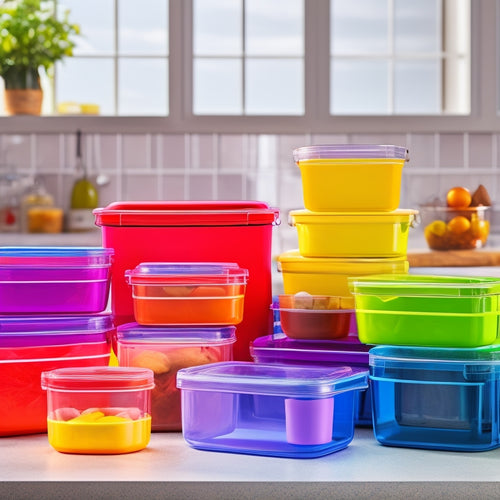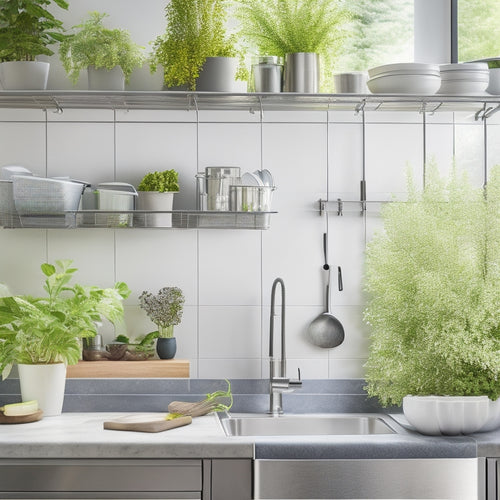
7 Essential Online Courses for Kitchen Inventory Success
Share
You're likely throwing away 25% of your kitchen's budget on unnecessary ingredients and inventory mistakes. To transform your kitchen's efficiency and profitability, focus on seven essential online courses. First, master kitchen inventory fundamentals, including demand forecasting and tracking. Next, optimize storage and organization with labeling systems and vertical space use. Then, create meal plans and grocery lists, and streamline kitchen workflow with task allocation and a 'clean as you go' policy. Continue with inventory management software training, food safety and waste reduction strategies, and advanced inventory techniques. By mastering these areas, you'll be well on your way to opening up a more efficient kitchen - and maximizing your budget's potential.
Key Takeaways
• Mastering kitchen inventory fundamentals, including demand forecasting and categorizing inventory, is crucial for success.
• Online courses should cover efficient storage and organization strategies, such as labeling systems and vertical storage.
• Meal planning and grocery lists are essential skills for kitchen inventory management, and online courses should address these topics.
• Inventory management software training is vital for automating ordering, analyzing sales data, and reducing waste and costs.
• Advanced kitchen inventory strategies, including inventory analysis, real-time monitoring, and supply chain development, should be covered in online courses.
Mastering Kitchen Inventory Fundamentals
You start building a solid kitchen inventory management system by understanding the core components that make it tick, including accurate demand forecasting, categorizing and tracking inventory, and maintaining a clean and organized storage space.
To master kitchen inventory fundamentals, you need to focus on inventory tracking, which involves monitoring stock levels, identifying slow-moving items, and optimizing your ordering process. This requires implementing a system that allows you to track inventory in real-time, so you can make informed decisions about what to order and when.
Another essential aspect of inventory management is stock rotation. This involves ensuring that older items are used before newer ones to minimize waste and reduce the risk of expired or spoiled products. By implementing a 'first-in, first-out' system, you can guarantee that your kitchen is always stocked with fresh ingredients and reduce the risk of contamination.
Efficient Storage and Organization
Organizing your storage space efficiently is essential to maintaining a well-run kitchen, as it enables easy access to ingredients, reduces clutter, and saves time during food preparation. You'll want to focus on pantry organization by categorizing items into groups, such as baking supplies, spices, and canned goods. Implement a labeling system to identify what's inside containers, making it easy to find what you need at a glance. This will also help you identify expired or spoiled items.
When it comes to space optimization, think vertically by using stackable containers and shelves to maximize your storage capacity. Choose containers that are airtight, easy to clean, and fit your specific storage needs. Consider the items you use most frequently and store them in easy-to-reach locations.
Meal Planning and Grocery Lists
With your newly organized kitchen storage in place, creating a meal plan and corresponding grocery list becomes a streamlined process that saves you time and reduces food waste.
Now, you can focus on planning nutritious meals that cater to your family's tastes and dietary needs. Start by browsing recipe inspiration online or in cookbooks, considering your pantry organization and the ingredients you already have on hand. This will help you create a budget meal plan that maximizes your grocery budget.
Next, make a list of the ingredients you need to buy, grouping similar items together (e.g., produce, proteins, dairy). Set a realistic grocery budget and stick to it by avoiding impulse purchases. Consider shopping sales or buying in bulk to reduce costs.
As you plan your meals, think about leftovers and how you can repurpose them to minimize waste. By taking the time to plan your meals and make a thoughtful grocery list, you'll save money, reduce stress, and enjoy healthy, home-cooked meals with your loved ones.
Kitchen Workflow and Productivity
By streamlining your kitchen workflow, you'll be able to cook and prepare meals more efficiently, freeing up time for other activities and reducing stress in the process. This is where effective time management comes in. By prioritizing tasks and allocating specific times for each activity, you'll be able to complete tasks quickly and avoid procrastination.
For instance, set aside specific times for meal prep, cooking, and cleaning to secure a smooth workflow. Optimizing your kitchen workflow also involves assigning tasks to specific stations or zones. Designate areas for food preparation, cooking, and plating to reduce clutter and confusion. This will enable you to move efficiently between tasks and minimize waste.
Implementing a 'clean as you go' policy can also save you time in the long run. By washing utensils and dishes immediately after use, you'll avoid a massive cleanup at the end of the day.
Inventory Management Software Training
Mastering inventory management software is essential to maintaining a seamless kitchen workflow, as it allows you to accurately track stock levels, automate orders, and reduce food waste. By taking an online course in inventory management software training, you'll gain the skills to streamline your kitchen operations and make data-driven decisions.
Here are just a few benefits you can expect from mastering inventory management software:
-
Effortless ordering: Automate orders and reduce the risk of human error, ensuring you always have the ingredients you need on hand.
-
Data analysis made easy: Learn how to analyze sales data and trends to optimize your menu and inventory.
-
Seamless software integration: Discover how to integrate your inventory management software with other systems, such as point-of-sale and accounting software, to create a cohesive kitchen ecosystem.
-
Reduced waste and costs: Accurately track inventory levels and identify areas for improvement, reducing waste and saving you money.
-
More time for what matters: With inventory management software handling the heavy lifting, you'll have more time to focus on what you love – serving your customers and creating delicious dishes.
Food Safety and Waste Reduction
You'll decrease the risk of foodborne illnesses and minimize waste by implementing effective inventory management strategies that prioritize food safety and expiration date tracking. This means regularly checking expiration dates and using the 'first in, first out' rule to make sure older items are consumed before they spoil.
Food rotation techniques, such as labeling and organizing products by date, will help you keep track of what needs to be used first. Additionally, implementing portion control methods will help reduce waste by preventing over-preparation of ingredients. By accurately measuring ingredients and preparing only what's needed, you'll avoid throwing away excess food.
Moreover, consider implementing a 'use-by' system, where you designate specific dates for using up products nearing expiration. By following these strategies, you'll not only reduce waste but also create a safe and healthy environment for your customers. By prioritizing food safety and waste reduction, you'll take a vital step towards maintaining a successful kitchen inventory.
Advanced Kitchen Inventory Strategies
To enhance your kitchen's inventory management to the next level, implementing advanced strategies is essential in streamlining your operations, reducing costs, and increasing efficiency. By mastering advanced techniques, you'll be able to make data-driven decisions that propel your kitchen's success.
Here are some advanced strategies to elevate your inventory management:
-
Conduct thorough inventory analysis: Delve into your data to identify trends, patterns, and areas for improvement. This will help you optimize your inventory levels and minimize waste.
-
Implement data tracking: Monitor your inventory levels in real-time to make sure you're always stocked up on essential items.
-
Develop a strong supply chain: Build relationships with dependable suppliers to guarantee a consistent flow of high-quality ingredients.
-
Master forecasting techniques: Utilize historical data and seasonal trends to accurately predict your inventory needs.
-
Analyze your menu engineering: Evaluate your menu to discover opportunities to minimize waste, optimize inventory, and increase profitability.
Frequently Asked Questions
Can I Customize Inventory Systems for Specific Kitchen Types or Cuisines?
You can create customized systems tailored to specific kitchen types or cuisines, ensuring accurate inventory management. For instance, a sushi restaurant's inventory system might focus on tracking seafood and rice quantities, while an Italian kitchen's system would prioritize pasta and sauce stock.
How Do I Handle Inventory for Seasonal or Specialty Ingredients?
'When in doubt, throw it out' is a good rule to live by. You'll preserve freshness and avoid waste by managing expiration dates, tracking seasonal ingredient availability, and scheduling regular inventory checks to guarantee only the best makes it to the plate.
Are There Any Courses Focused on Kitchen Inventory for Food Trucks?
You'll find courses specifically designed for food truck operations, teaching you inventory management techniques to optimize storage, minimize waste, and streamline ordering processes, ensuring you're always stocked and ready to serve customers on-the-go.
Can I Learn Kitchen Inventory Skills Without Prior Kitchen Experience?
You're starting from scratch, like a blank recipe page, but don't worry, you can still whip up kitchen inventory skills! You'll learn to navigate inventory software and develop essential skills through online courses, even without prior kitchen experience.
Are Online Courses Suitable for Kitchen Teams or Just Individual Learners?
You're wondering if online courses are better suited for individual learners or entire kitchen teams. The answer is, they can benefit both! With online courses, you can learn at your own pace, while teams can upskill together, improving communication and workflow.
Related Posts
-

Stackable Kitchen Containers for Modular Systems
Stackable kitchen containers for modular systems change your cooking space by maximizing vertical storage and enhanci...
-

Wall-Mounted Dish Drainer Racks for Kitchens
Wall-mounted dish drainer racks are a game changer for your kitchen. They maximize vertical space, freeing up preciou...
-

Wall-Mounted Racks for Kitchen Tool Storage
Wall-mounted racks are perfect for maximizing storage in your kitchen. By utilizing vertical space, you can free up u...


